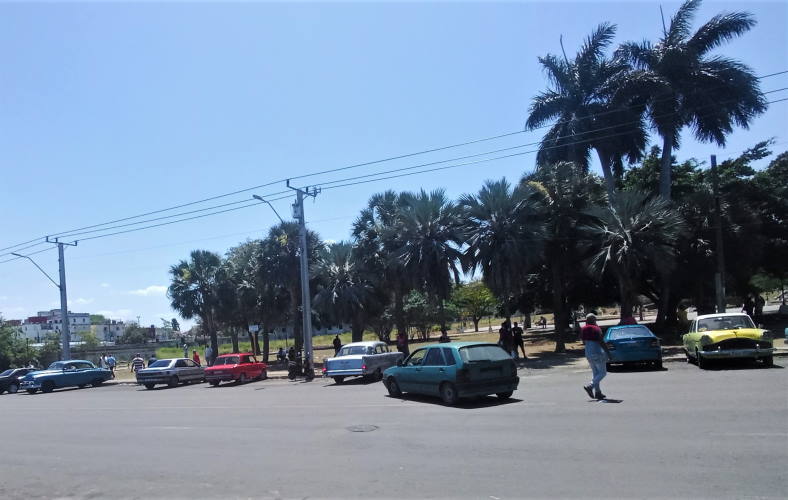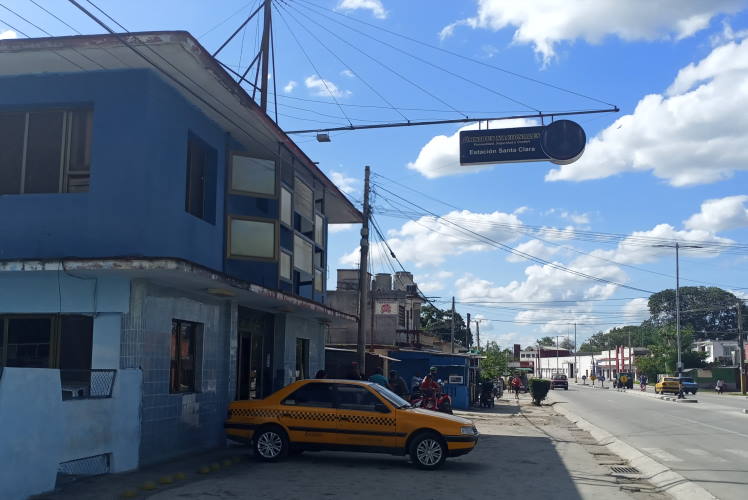VILLA CLARA, Cuba. — Under one of the palm trees in front of the Havana Bus TerminalYasmany has a heated conversation with one of the taxi drivers. He can be heard swearing as he presses his fists against the shoulders of the much older boatman, who drives a dark-glass Lada with air conditioning. Minutes before, the 24-year-old “vessel” had pounced on a couple of tourists who disembarked nearby in search of transportation to Cienfuegos. He was seen running up to them and roughly waving their bags as he invited them to follow him in incoherent language.
From the back seat of the taxi, the man and the woman — both Italians — pay attention to the conversation with some interest, as if it were a matter of folklore, a daily custom of Cubans, for them so passionate and vehement in their conversations. . To calm the young man’s spirits and “get rid of him” in the afternoon, the boatman ends up handing him a 1,000-peso bill, to which he replies with “I’ll wait for you right here, you heard.”
A little less than a week ago Yasmany had to pay a fine for public disorder. He was the cause of a fight in the same place with another of the ships that claimed to have managed four passengers to Santiago de Cuba. “If it had been for another place, no problem, I’ll back down, but if it’s for the East I’ll get at least three thousand canes.”
“I’m like that, kind of complicated,” he justifies himself as he wipes the sweat from his forehead and takes a seat in one of the blocks arranged as seats in the terminal park. “What happens is that these boatmen want to put their foot in you. These were yumas that were going to pay in euros, do you understand?, because they had just arrived. That smells. I’m an old dog at this.”
Yasmany is a black-skinned boy. His appearance resembles the image of poor Cubans that most movies have tried to convey. He may be the cliche of all buns: he wears a sleeveless shirt with an American flag, shorts, strapless sandals, and a snug-fitting fanny pack where he keeps all his earnings for the day. “Nothing, I didn’t study anything,” he says. “But I have two girls with different mothers that I have to support. You see me like this, with this look, but I make my money to break Havana”.
In the same area there are more than fifteen vessels, authorized or not, legal or not. Of course, not everyone is welcome in the piqueras, to be accepted you often have to pay a tax. None of them are presented with the state terminology of “passage managers”; they simply are and will be “vessels”, the popular word that recognized them when the government still did not tolerate this activity on its own. Those who abound in the area in question do not usually exceed 30 years and among their main aspirations is “to make enough money to emigrate”.
The terror of drivers
At the entrance to the Cienfuegos terminal, Rubén is known as “El Toqui” because his minuscule build resembles the popular puppet that was broadcast on Cuban television in the 1980s. However, “El Toqui” is also related to his repeated disputes with the boats in the area, with whom he has gotten into a fistfight on several occasions.
“They’re all scoundrels,” he snaps as he gobbles up a pizza bought at a nearby paladar. “Fights between the boatmen and them are quite common because when you don’t have the money upstairs, they wait for you when you arrive to charge you. Recently, a tremendous ferretreque was formed with some young tourists who were going to Rancho Luna. The ship that pulled them and pulled them by the arms and they ended up hitting them on the head with a bag. What kind of image do these people of Cuba take with them!”
In most of the piqueras in the center of the country, if the passengers are of another nationality, the vessels require the drivers to pay in foreign currency or, failing that, the equivalent in national currency. Thus, for example, a trip to Los Cayos de Villa Clara, which can cost from 50 to 60 dollars or euros, the boatmen must pay a commission of twenty USD, 25 MLC or 2,500 pesos. The truth is that this is a fairly well-paid job, while, in view of the police, many boats extort money from tourists and blackmail drivers.
At the Santa Clara terminal, Armando, another driver who travels to the provinces, explains that the vessels make his work difficult and more expensive. It happens that the taxi driver must almost always be subordinate to these ticket managers, which can “scare” the clientele at the moment they discuss the commission.

“They do not charge the taxi driver, rather they demand it,” he explains. “Each trip has its price, depending on the distance and the fuel that is spent, the ship that what it does is alter that price. If I want to go for 1,000 pesos to one side, they come and tell you that 1,500. Some are more cheeky and bring you the race in half: fifty fiftywithout buying gasoline or taking a four-hour trip”.
The boatman also affirms that any ship that makes more free money than a driver, although he considers that there are much more unscrupulous intermediaries than these same managers: “I understand that people look for life. If you want to lay money on the yumas, well, all in all, everyone needs to eat. The problem is not the vessels. My grandmother always said that necessity debases a man.

Asiel is another vessel from Santa Clara who neither dresses nor behaves like Yasmany. He is a graduate of Intermediate Technician, but for years he has been managing passengers near the Riviera store, in front of the terminal. When the salaries went up, he also increased his commission because he is also prepared to negotiate in English, Italian and “a little bit of French”, even though he only knows the basic phrases to do his job.
“I address foreigners with love, with affection,” he says. “Here people run and the tourists get scared: they repeat taxi!, taxi!, and they don’t like that, it stuns them. My favorites are the Argentine ones, because they can sell you a complete tour: I’m talking about Che, the Armored Train, about everything you can see in Santa Clara. It goes and one day one falls in love with me and you already know”.
Receive information from CubaNet on your cell phone through WhatsApp. Send us a message with the word “CUBA” on the phone +1 (786) 316-2072, You can also subscribe to our electronic newsletter by giving click here.






